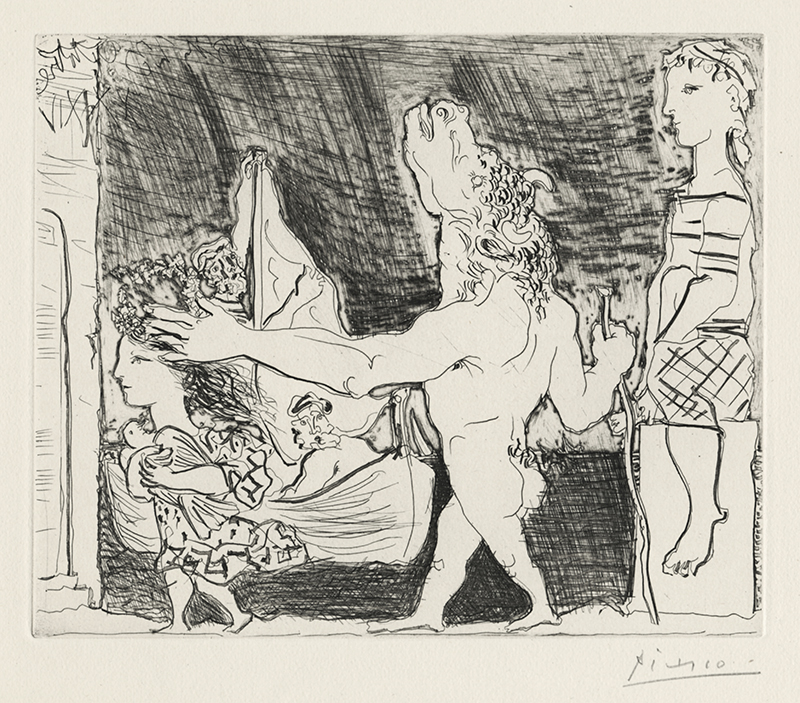Minotaure aveugle guide par une Fillette, II, is an etching and drypoint from 1934 by Pablo Picasso. It was published in 1939 as part of La Suite Vollard. This impression is pencil signed and was printed by Roger Lacourière in an edition of 250 on ivory Montval laid paper with the Vollard watermark. The references are Block 223 and Baer 435 B c. The platemark measures 9-3/8 x 11-3/4 inches.
The publisher Ambroise Vollard approached Picasso in 1930 about his idea of a suite of 100 etchings based upon neo-classical themes. The suite, known as La Suite Vollard, features five major themes, loosely known as The Battle of Love, Rembrandt, the Minotaur, Blind Minotaur, and the Sculptor’s studio. The minotaur originated in Greek mythology and was a fabulous monster of Crete with the body of a man and head of a bull. Picasso empathized with the minotaur as the theme is repeated several times. Here, the blinded minotaur represents Picasso in middle age being led by his lover Marie-Therese, shown as a child holding a dove.
Pablo Picasso, painter, sculptor, printmaker, and ceramist, was born in coastal Malaga, Spain, on October 25, 1881. Picasso’s mother, Maria Picasso Lopez, recognized her son’s talent and encouraged his pursuit of art. She arranged for Don Jose Ruiz y Blasco, an artist and art professor, to teach Picasso drawing and painting from an early age. He also studied under his father before attending La Llotja Art Institute and he was later sent to the Royal Academy of San Fernando in Madrid. Picasso was not an academician and preferred studying paintings at the Prado. The young artist experimented with different techniques and mediums, including printmaking, and produced his first etching in 1899.
Picasso visited Paris for the first time in 1900 where he met French writer Max Jacob. The following year Picasso moved to Paris where he and Jacob shared a small studio. In 1904, Picasso began experimenting with printmaking once again, creating the Saltimbanque Suite of fifteen intaglios. These languished several years until his art dealer, Ambroise Vollard, took notice of them and published them in an edition of 250.
Picasso soon became attached to the circle of intellectuals, artists, and
writers led by Gertrude Stein. This brought him into contact with key people in
the art world, including Henri Matisse and Georges Braque. Together Picasso and
Braque established one of art history's most famed genres, Cubism. Among Picasso’s
Cubist sub-genres were "analytic cubism" and "synthetic cubism,"
both investigations of art executed through forms of deconstruction.
Exempted from conscription into the First World War due to his Spanish
citizenship, Picasso continued to work in Avignon and traveled for the first
time to Italy, where he found inspiration in the figurative antiquities of Rome
and Greece. In the early 1920s his work largely departed from Cubism and he produced
figurative compositions in formal or neoclassical poses.
In 1931, Picasso’s interest in intaglio printmaking was revived when publisher
Ambroise Vollard invited him to create a suite of 100 etchings. This endeavor would
prove to be a boon of experience for Picasso, working at first alone and then,
in 1934, with master printmaker Roger Lacourière who introduced him to new
techniques, such as sugar-lift. The images were created in a neoclassical style,
meditating on themes of love, war, old age and youth. La Suite Vollard became Picasso’s most
famous collection of printed works. Picasso finished the plates in 1937 and
handed them over for printing to Lacourière but Vollard would not live to see
their publication. With the onset of World War II, Picasso was unable to obtain
plates and other materials, and his printmaking pursuit was put on hold. He created
over 1,400 etchings, lithographs, and blockprints throughout his career,
working with leading experimental printmaker Stanley William Hayter, Atelier
Mourlot, Hidalgo Arnéra, and the Crommelnyck brothers.
Picasso remained in Paris, harassed by the occupying Gestapo forces for his “degenerate” art but never arrested. He continued to paint and to illegally produce cast bronze sculptures with the help of the French Resistance. With the liberation of Paris in 1944 his reputation had not dissipated. He began to exhibit almost immediately and he would continue to live and work in Mougins, France, until his death on April 8, 1973.
Picasso is undoubtedly one of the most influential artists of the 20th century. According to Konstantin Bazarov, he has often been compared with Stravinsky as one of the great chameleons of his time, each reacting to the crisis of expression in modern art by constantly exploring, thus passing through a whole series of phases of creative activity.



